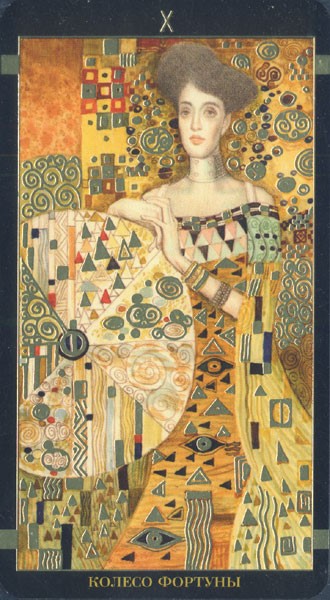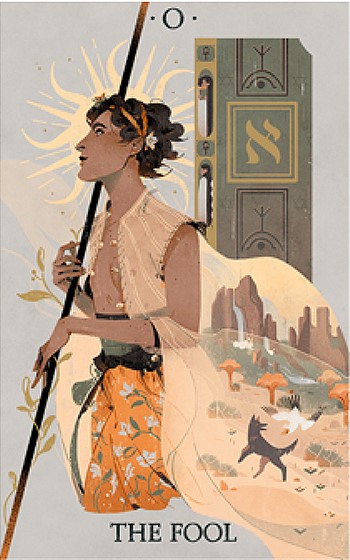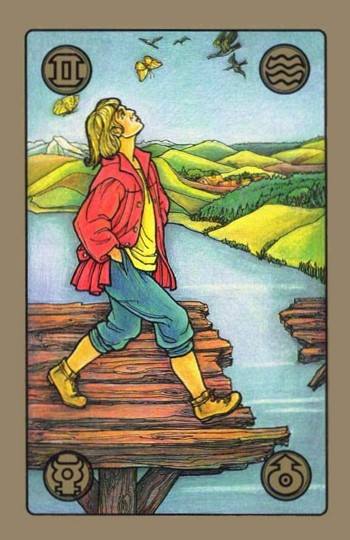ARTICLE

Are Tarot images relevant in fortune-telling? Meditate on extrasensory perception and oracular right-guessing by using psychic magnetism on symbolic systems.
Tools usage
Do images make any sense? Even though the suits have specific meanings, we choose a deck among several ones because, by making use of cards (or water or any other natural element, or tossing coins, grouping rods or any other matter allowing to focus the attention...) is about flowing by setting our body in motion.
Where is your body at? It's at the place you're moving to, at the time you're going to. One of the vital principles involved in the process is the etheric interdependence of beings and things, by which barriers are no more, definitions lose functionality, and separation disappears.
All sensorial experiences goes against this type of extrasensory and psychic dimension. Even the chosen cards may push you away from it because they're expressing shapes, some of them more concrete, some others more abstract, but in the end all of them evoke some sensation or specific thought.
Somehow, the best oracular practice dismisses any tool to get an oracle such as it is, without taking away or changing any of its qualities, attributes or tendencies due to our perceptual conditionings.
Meanings and practices
Like with any other oracle, spreading cards and guessing right is about practicing with the own attention and magnetism. During your first practices, you surely were sticked to the traditional meanings of each card. But if you're interested in the oracular dimension of Tarot, then you should have checked if your reading was right or not.
Cards are tools for concentrating and focusing the attention, and for nothing else. If we need meanings to do so, we have them. But the most important thing for a right forecast is the experience, practice and observation taking us later back to each spread: did we effectively read what happened? Was our description accurate? Has the prediction become a fact?
In this very personal approach of each Tarot reader to cards, we may be close to or far from traditional meanings. It doesn't matter! Whatever meaning is assigned to a card, we have to see if it takes us to oracular facts or not. The easiest way to exercise it is inquiring about what we don't know and what we have no direct contact with either, about what is physically far away, and telling nobody about the reading (so we'll dismiss any possible interference). Look what happens over time, and then tell me!
Orderings and systems
Divinatory practices are always evoking some type of symbolic ordering to understand cards. Orderings of all kinds, from worldviews about life and death to orderings that provide a structure to daily relationships, situations, people and things.
Our particular way to feel, think and sense is included in those schemes: what is expected in each situation? We may easily project our point of view into a reading but, again, if you're interested in the oracular value of mancies, the observation and practice will make you leave aside what interferes with extrasensory perception.
An arcane is a tendency, a situation, a thought, a sensation. From the past, present, future. Behind it, the rest of 77 cards show up.
This is about personal preferences too! If practices and observations of facts have made us choose a particular deck and not other one, then we'll be closer to understand the meanings a specific deck holds inside. The understanding may be traditional or modern, very simple or complex, classical or innovating... So mancies provide their own meanings and particular logics, which we incorporate to ours: our particular ways join those of arcana, and then an oracular whole emerges and expresses each Tarot reader's skills and singular style.
Some decks
The Golden Tarot by A. Atanassov is inspired by Gustav Klimt's paintings. It's a dreamlike deck, great to focus on images and get lost. Human figures are usually naked or dressed in clothes fused with backgrounds or the rest of elements on the cards. Informality and allegories take us to meditate on different subjects too, especially on parameters about what is normal and proper, sensuality and beauty, so the deck is a great tool to expand the perception and sense any type of situation being inquired, becoming the reader one with it.


Fortune (10)
The Outsider Tarot by Bobby Abate brings a more definite although eclectic deck. It comes from a particular time, the current one, the visual one, an age about calling the attention, the personalistic among the crowd. With special astrological references, it brings radical innovations by adding roses (coins, Earth) and eyes (swords, Air). Using the deck is a whole challenge for divinatory practices because we need to know traditional meanings and also make changes in our perception, in several ways: about how the situations are considered to grow and developed, and about modern life perceptions (the way people look at and see each other). This is the world Bobby displays in his artwork.


Sefirot by Causa Creations is part of a game inspired by the Jewish cabbalah, so we have to know the sephirot and the worldview coming along with it. However, the sephirot on the two-player board are not always associated to planets such as they do inside of the traditional Tree of Life. As you can appreciate, some Tarot decks include more complex systems to guide our readings, and also bring deeper meanings...


Symbolon by Peter Orban & Ingrid Zinnel is a contemporary deck too, because it was designed according to the archetypical and psychological inheritance from Europe. You can easily appreciate it in the designs, in a frame to perceive roles, activities and situations in the human imagination and daily life during the last centuries. As it happens with the deck mentioned above, this one focuses our readings on planets and signs of the Western Zodiac too, and the authors don't consider it as an oracular mean.


Tarot with astrological correspondences by Xul Solar is one of the more complex decks I know. It's been designed by taking into account some basic astrological concepts as well as different types of languages!: polarities, positional and light/dark games, relativity, relations of signs, aspects patterns, numbers, planets... Being the author an Argentinian esotericist, the cards are associated to the Spanish alphabet inside of a complicated system with a highly structured logic to guide the perception. If you're particularly interested in esotericism, then you may use the deck to focus on subjects not easily noticed in daily life...







Comments
Join and leave a message. I always answer personally, and as soon as possible.